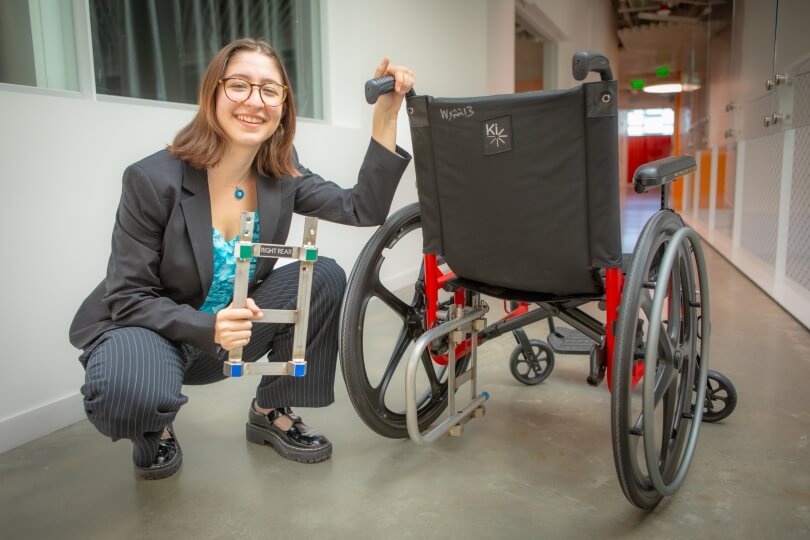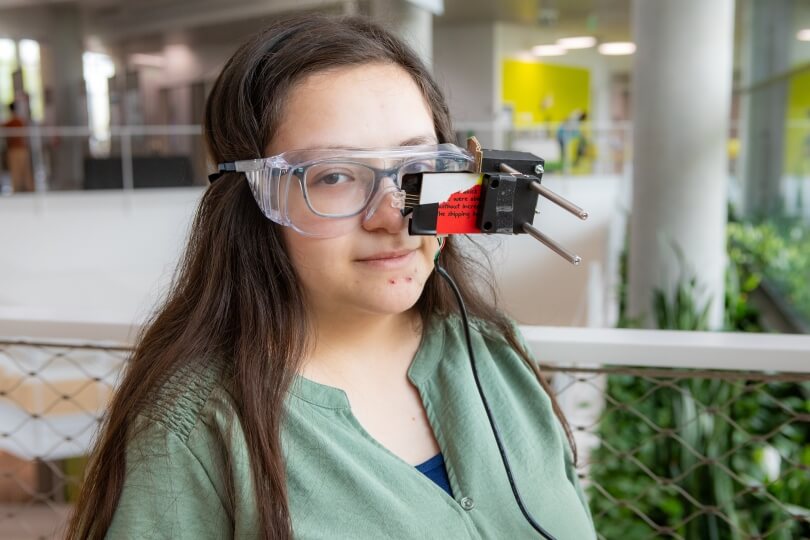Zeynep Bromberg, S.B. '24, in mechanical engineering (Eliza Grinnell/SEAS)
A trip to New York City showed Zeynep Bromberg just how easy it can be for wheelchair users to feel isolated from their communities. Bromberg, a fourth-year mechanical engineering student at the Harvard John A. Paulson School of Engineering and Applied Sciences (SEAS) is a singer with the Harvard-Radcliffe Collegium Musicum, and organized the club’s trip to sing at Carnegie Hall and the Lincoln Center last spring. She requested the buses to and from New York have wheelchair accessibility to accommodate a fellow singer but when the buses arrived, neither driver knew how to operate the wheelchair lift.
“It was a really painful situation, and we saw it happen over and over again,” Bromberg said. “It was such a headache, and it was emotionally very difficult for my friend in the chorus. She had no autonomy over the situation, because there was nothing she could do to make the process go any faster. I remember really distinctly being on the bus on the ride home and thinking this was an engineering problem. It’s a social problem, the way we treat accessibility and disability as a society, but it’s also an engineering problem.”
Bromberg and fourth-year electrical engineering student Anna Ramos recently completed senior capstone projects focused on adaptive technology. Bromberg designed a lightweight securement system to make it much easier for wheelchairs to be safely strapped into a public transportation vehicle, while Ramos converted standard safety goggles into a video game controller that uses eye movement instead of joysticks or buttons. Ramos's project won Honorable Mention at the Dean’s Award for Outstanding Engineering Projects ceremony.
“I thought it was a great combination of being able to explicitly help someone and a fun way to challenge myself,” Ramos said. “I’ve always been very oriented around electrical engineering and computer science, and it seemed like a good way to bring me back to my computer science roots.”
Anna Ramos, S.B. '24, in electrical engineering (Eliza Grinnell/SEAS)
Both projects emerged out of a collaboration between SEAS and Brooke Ellison, the first quadriplegic graduate from Harvard. Ellison studied cognitive neuroscience as an undergraduate and earned a master’s in public policy at Harvard Kennedy School. She later earned a Ph.D. from Stony Brook University, where she eventually became an associate professor at the Center for Medical Humanities, Compassionate Care, and Bioethics.
Ellison died earlier this year from complications of quadriplegia. She was 45.
Wanting to work with students to design adaptive technology, Ellison had contacted SEAS through Rebecca Nesson, Dean for Academic Programs who connected her with Salma Abu Ayyash, Preceptor in Education Innovation and coordinator for “ES100: Engineering Design Projects,” the year-long senior capstone project for engineering S.B. students.
“There is so much that can be done to serve this community, so many hidden problems that are not visible to the rest of us,” Abu Ayyash said. “Sometimes the solutions are not difficult – rather they are simple creative solutions that our students can engage in, and that can make such a big difference. It's a human rights issue at its heart; there just needs to be the will and focus.”
Ramos and Bromberg both designed their projects through their interactions with Ellison. They spoke with her several times in the fall, and also attended the StrongWheeled Together Conference, a large adaptive technology and innovation convention organized by the United Spinal Association, of which Ellison was Vice President for Tech Access.
“The conference was really wonderful in that it allowed me to get a better sense of the concept of user-centered design,” Bromberg said. “When you’re creating technical specifications, it’s impossible to craft it for every single individual user, so we tend to make generalizations. But when you’re designing for people with disabilities, those differences can define whether the device can or can’t be used by certain people.”
“Brooke emphasized a lot the importance of making sure the user is comfortable with your technology,” Ramos said. “Sometimes you just work on what’s already out there, incorporating user feedback.”
Ramos and Bromberg were deeply inspired by their work with Ellison.
“Brooke was such a great soul,” Ramos said. “She was so enthusiastic, and I learned a lot from her in just those few meetings. She was so able to elegantly word the issues the disabled community is facing, while balancing that with the element of universal design.”
Bromberg added, “She was so lively and had so much spirit, and you got the sense that when you were talking to her that she had her hands in everything in the world. When we were at the StrongWheeled Together conference, everybody knew who Dr. Ellison was. She was familiar with so many projects and initiatives across so many academic disciplines. At the same time, she could be so attentive. She read through all my initial proposals, gave me a lot of really good feedback.”
Bromberg and Ramos hadn’t thought much about designing adaptive technology before undertaking these projects with Ellison, but both came away from the experience with a much greater understanding of how central user comfort is when designing a product. That lesson could benefit both of them in the next stages of their lives. Bromberg, whose long-term goal is to work in public transit, will be pursuing a Master’s in Sustainable Design and Infrastructure at Stanford’s School of Civil and Environmental Engineering next year. Ramos may return to her home state of Texas to attend graduate school, but is also applying for engineering jobs.
More collaborations with Ellison were discussed throughout the year, Abu Ayyash said, including an interdisciplinary program on public policy, business and engineering, and other efforts to bring more human-centric elements to the design curriculum. Her hope is that this collaboration will continue through the United Spinal Association, and that more ES100 students will be able to work on solving problems similar to the ones chosen by Bromberg and Ramos.
“It pains me so much that Brooke passed away before we had a chance to work more together,” Abu Ayyash said. “I only knew her for a year, but her vision, creativity, determination and kindness made her a very unique person. I sincerely hope that her legacy will continue and folks connected to Brooke from Harvard and elsewhere will bring her vision to reality.”
Press Contact
Matt Goisman | mgoisman@g.harvard.edu

